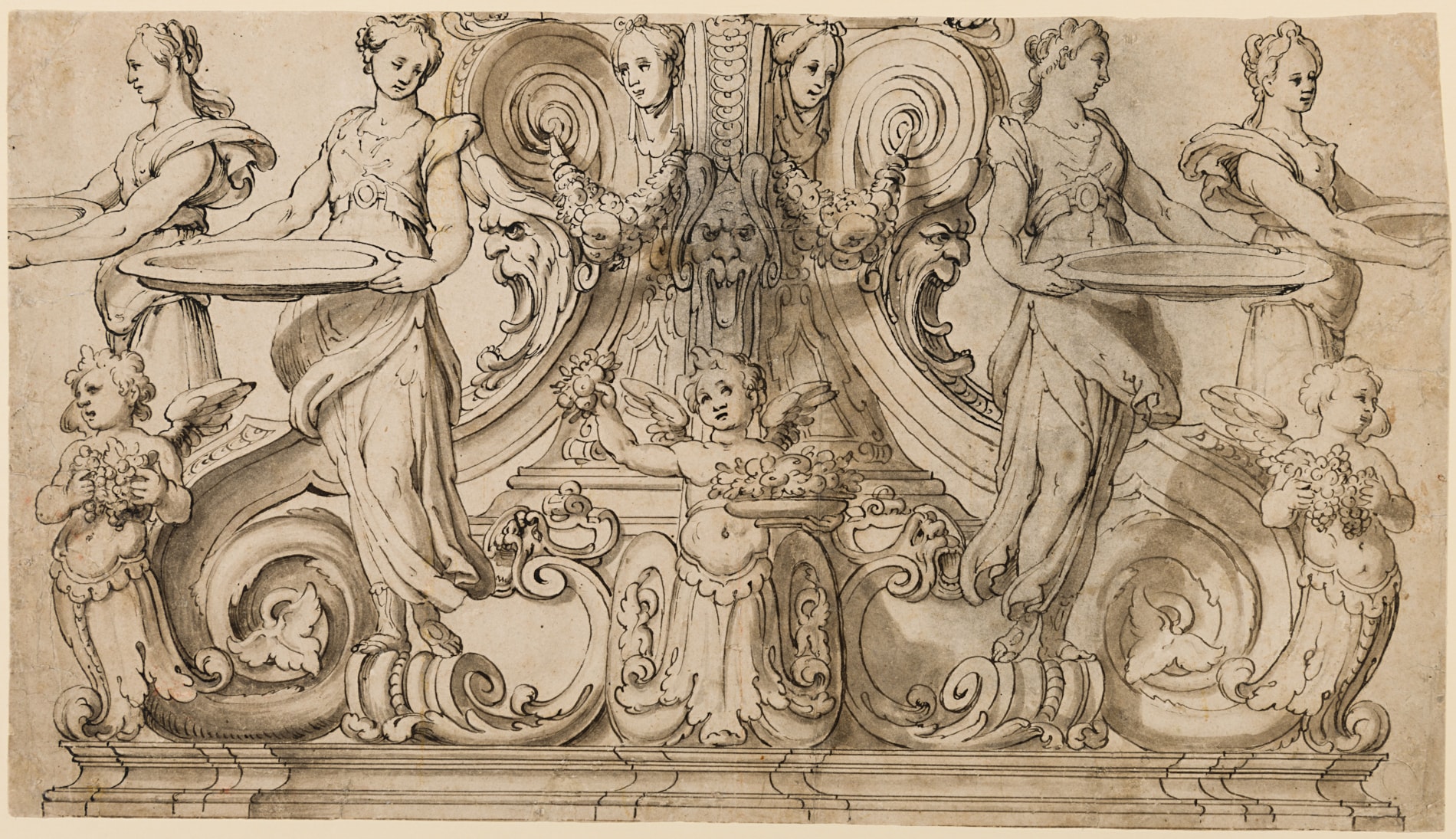Ermenegildo LODI
(Cremona c.1575 - Cremona c.1616)
Design for the Ornamental Base of a Table
Pen and black ink and grey wash, over traces of an underdrawing in black chalk; the sheet backed.
The outlines of one of the female figures and the central mascaroon pricked for transfer.
241 x 430 mm. (9 1/2 x 16 7/8 in.)
The outlines of one of the female figures and the central mascaroon pricked for transfer.
241 x 430 mm. (9 1/2 x 16 7/8 in.)
Similar Mannerist decorative elements - including masks, terms, volutes and acanthus-leaf scrolls - are found in a large drawing by Ermenegildo Lodi for the decoration of a ceiling, today in the Louvre, while also somewhat similar is a small pen and grey wash drawing of an ornamental base with caryatids and masks, currently attributed to Malosso, in the Uffizi in Florence. The facial type of the figures in the present sheet is also typical of Lodi’s drawings, as seen for example in a drawing of a Sibyl in the collection of the University of Iowa Museum of Art in Iowa City.
Active in Cremona in the first quarter of the 17th century, Ermenegildo Lodi was a pupil of the Cremonese painter and architect Giovanni Battista Trotti, known as Il Malosso (1556-1619), and is documented between 1594 and 1630. Among his earliest works is a painting of The Virgin with Saints Peter and Jacob, signed and dated 1598, in the church of San Rocco at Bussetto, near Parma, while the following year he is recorded as working in the Duomo at Salò. Lodi’s independent career seems to have begun around 1604, when Malosso left Cremona for Parma. From 1608 onwards Lodi worked in the church of San Siro in Soresina, where he painted the right transept and the vault and dome of the presbytery with scenes from the life of the Virgin. Lodi also completed the extensive decoration of the vault of the church of San Pietro al Po in Cremona, a project begun by Malosso around 1587, although he had only completed the first bay of the nave. Despite the long period of time between Malosso’s work and Lodi’s eventual completion of the decoration, such was his familiarity with Malosso’s manner of painting that the younger artist was able to achieve a visual coherence in the appearance of the nave as a whole. This was arguably the most significant public commission of Lodi’s career, and the artist proudly signed and dated the work, which was completed in 1616. He also painted a Preaching of Saint John the Baptist for the baptismal font of the same church. Lodi’s father Manfredo and brother Giovanni Battista were also artists.
Ermenegildo Lodi’s draughtsmanship owes much to that of his master Malosso, and indeed their drawing style is sometimes so close that, as the 17th Florentine biographer Filippo Baldinucci noted, ‘the work of one could be exchanged for the work of the other.’ (Lodi also seems to have retained a number of drawings by Malosso after the elder artist’s death, from which he continued to derive inspiration for some of the figures in his later projects.) Several drawings by Lodi are today in the Uffizi in Florence and the Museo Civico Ala Ponzone in Cremona, and other examples are in the Ashmolean Museum in Oxford, the Metropolitan Museum of Art in New York, the Galleria dell’Accademia in Venice, and elsewhere.
Ermenegildo Lodi’s draughtsmanship owes much to that of his master Malosso, and indeed their drawing style is sometimes so close that, as the 17th Florentine biographer Filippo Baldinucci noted, ‘the work of one could be exchanged for the work of the other.’ (Lodi also seems to have retained a number of drawings by Malosso after the elder artist’s death, from which he continued to derive inspiration for some of the figures in his later projects.) Several drawings by Lodi are today in the Uffizi in Florence and the Museo Civico Ala Ponzone in Cremona, and other examples are in the Ashmolean Museum in Oxford, the Metropolitan Museum of Art in New York, the Galleria dell’Accademia in Venice, and elsewhere.




